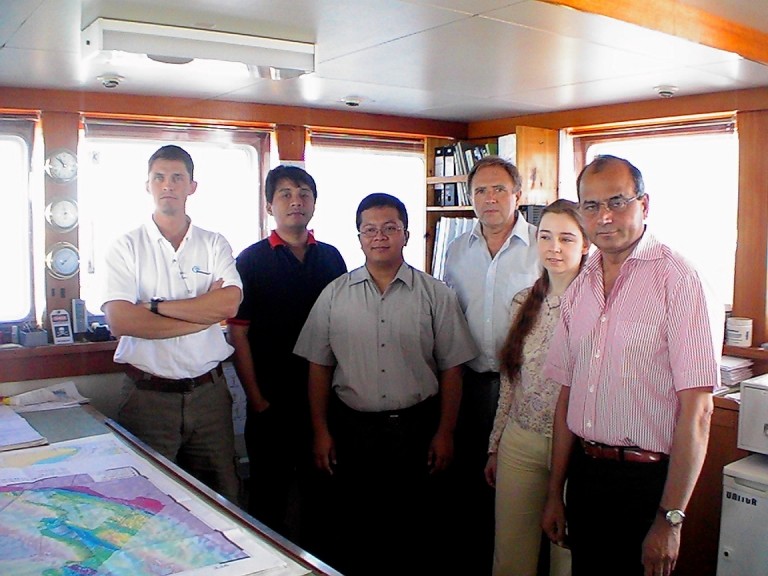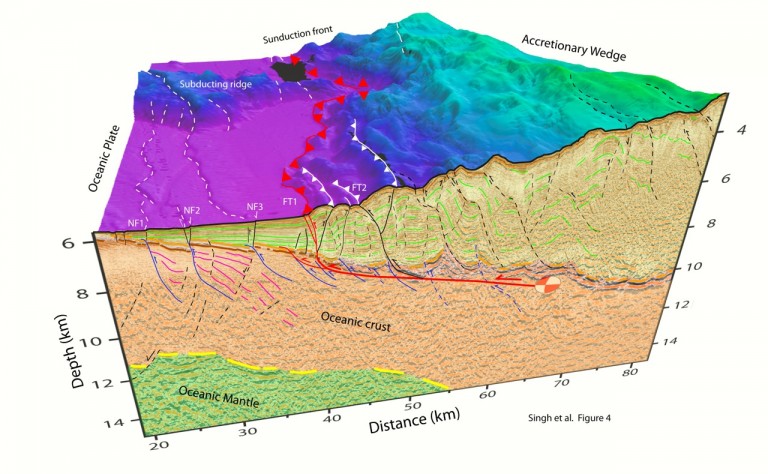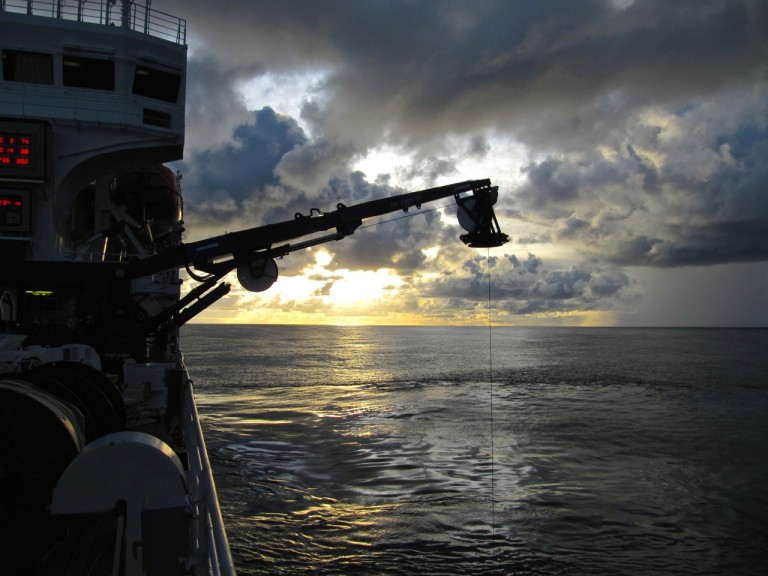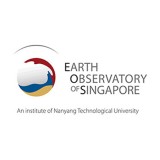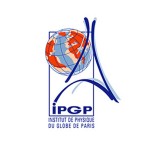In the past decade the world has been repeatedly reminded that tsunamis are one of the most destructive forces on the planet, but their causes remain poorly understood.
The region west of Sumatra in Indonesia is particularly prone to tsunami-spawning earthquakes and will likely endure a major hit in the near future, making it an important, if unfortunate, geological laboratory. In May, Falkor took a team of geophysicists to Indonesia for an unprecedented, high-tech expedition designed to clarify the mechanisms that cause tsunamis, and help millions to better prepare for a tsunami that could follow the massive earthquake anticipated in the relatively near future.
Prof. Satish Singh, from Institute of Physics of Paris Globe, and Dr. Nugroho Hananto of the Indonesia Institute of Sciences (LIPI) co-led the expedition, dubbed the Mentawai Gap-Tsunami Earthquake Risk Assessment, or MEGA-TERA. The project also included researchers from Earth Observatory of Singapore, an institute of Nanyang Technological University; and ran from late May to late June, 2015.
Locked in the Danger Zone
The target was the Sumatra-Andaman subduction zone, which runs parallel to the west side of Sumatra and the Mentawai Islands. It is the most seismically active region in the world, and in the last decade has endured multiple massive earthquakes that caused tsunamis with death tolls in the hundreds of thousands, including the 2004 Boxing Day tsunami that claimed more than 230,000 lives.
Over the last century, earthquakes have released built up tension along the entire Sumatra-Andaman zone, except for a single stretch west of Siberut Island. This zone, known as the Mentawai Gap, has not seen an earthquake in almost 200 years. It is referred to as a “locked zone” because the sections north and south of the subduction zone have slipped up to eight meters. That is eight meters of tension that will have to be released, likely leading to one or more major earthquakes. A key and so far unanswerable question is whether that release will spawn yet another devastating tsunami. In nearby Padang alone, over 500,000 people live within five meters of sea level, and there are more than seven million people living along the central and southern coasts of Sumatra and the Mentawai Islands.
Advanced Technologies
The team used advanced deep-sea mapping technologies to study the locked zone and surrounding portions of the subduction zone. A subduction zone is a place where one tectonic plate—the subducting plate— is slowly falling beneath an overlying plate. At the seafloor, such zones form spectacular ocean trenches, but the geological action is generally hidden below the seafloor. An earthquake occurs when tension builds up from the friction between the two plates, causing them to slip—sometimes meters in an instant. In general terms, that movement, which can push up the seafloor, is the agitation that creates a tsunami. But some of the specifics remain cloudy.
The shifts that cause tsunamis can occur thousands of meters below the sea surface, and hundreds or thousands of meters below the seafloor. In part because such zones are so difficult to access, research has been slow, leading to major unknowns. The devastating 2011 Tohoku earthquake in Japan occurred in a spot where many researchers believed that a major quake wasn’t even possible. In 2010, a 7.8 earthquake shook the subduction zone southwest of Pagai Island in Sumatra, launching a completely unexpected eight-meter-high tsunami.
Off Sumatra, the team studied the sites of past earthquakes [see map of historic quakes above], particularly the 2010 event, to assess their geological signatures, and to look for clues as to what seafloor deformations spawned tsunamis. Previous existing data from these areas was of much lower quality than what was generated during this expedition, but past records can be used for comparison to help spot the major changes.
Professors Singh and Tapponnier, and their team compared findings at other sites to what they saw at the locked zone, to delineate differences. Such work could enable forecasting of what to expect during a future earthquake. At the locked zone they also searched for clues about what happened during the last major events—in 1797 and 1833—to see if there might be similarities to the effects of more recent events nearby.
Importantly, the work created a very detailed snapshot of the locked zone. Nobody can forecast when earthquake slippage will occur there, but when it does, researchers will be able to remap the site and identify key changes.
How They Did It
The team created high-resolution maps of the target areas in water depths up to 5,000 meters or more using Falkor’s multibeam sonar system. This allowed them to make the comparisons between seafloor deformations tied to recent quakes and the seafloor within the locked zone. They also created bathymetry maps of areas between the locked zone and the islands to the east. These improved tsunami risk assessments, because the size and intensity of a tsunami, and ultimately how much inland inundation it causes, are all controlled by the water depths it travels through. A seismic sub-bottom profiling system was used to develop the subsurface maps.
There is particular interest in studying the wedged, leading edge of the subducting plate within the locked zone, because studies of past quakes, including the one off Pagai, suggest that the strong motion of this frontal section can cause a tsunami. This idea contradicted the conventional wisdom that frontal sections are too weak to slip during earthquakes. High-resolution images of the wedge and other features of the subduction zone were never before been available to scientists.
High Stakes Payoff
Even if scientists can’t yet predict the timing of quakes, the work on this expedition could lead to a reasonable forecast of the likelihood a quake in the region will cause a tsunami, and some potential scenarios for what the size and direction of such a tsunami would be. Considering the horrific impacts of past tsunamis here, such information—and the advance planning it would enable—will be invaluable for the millions of people living within potential tsunami paths. And, by clarifying tsunami generation processes, the work should also aid in forecasting and preparing for tsunamis around the world.
by Mark Schrope
Don’t forget to follow the cruise on our social media sites at #MEGATERA
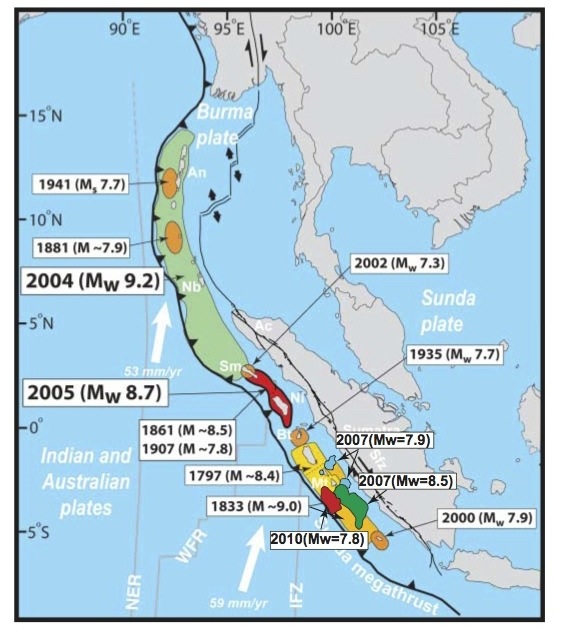
Data & Publications
The resulting shipboard dataset is being stored at the Rolling Deck to Repository and is now available.
- Crenshaw, G., and Sautter, L.. (2016). Geomorphology of the Sumatra Subduction Zone: Expressions of Tectonic and Seismic Activity, Poster Presentation, Canadian Hydrographic Conference, Halifax, NS, CAN.
- Singh, S., Hananto, N., Qin, Y., Leclerc, F., Avianto, P., Tapponier, P., Carton, H., Wei, S., Nugroho, A., Gemilang, W., Sieh, K., and Barbot, S. (2017). The Discovery of a Conjugate System of Faults in the Wharton Basin Intraplate Deformation Zone, Science Advances 2017 3: no. 1, e1601689, doi: 10.1126/sciadv.1601689. [This publication is available as OPEN ACCESS].
- Kornei, K. (2020). A Plate Boundary Emerges between India and Australia. EOS, 101, doi: 10.1029/2020EO144177.
- Bradley, K., Qin, Y., Carton, H., Hananto, N., Villanueva-Robles, F., Leclerc, F., et. al. (2019). Stratigraphic Control of Frontal Decollement Level and Structural Vergence and Implications for Tsunamigenic Earthquake Hazard in Sumatra, Indonesia. Geochemistry, Geophysics, Geosystems, 20(3), doi: 10.1029/2018/GC008025. [This article has been published as OPEN ACCESS].
- Coudrier-Curveur, A., Karakas, C., Singh, S., Tapponnier, P., Carton, H., and Hananto, N. (2020). Is There a Nascent Plate Boundary in the Northern Italian Ocean? Geophyical Research Letters, 47(7), doi: 10.1029/2020GL087362. [This article is published as OPEN ACCESS].
- Hananto, N., Leclerc, F., Li, L., Etchebes, M., Carton, H., Tapponnier, P., et. al. (2020). Tsunami earthquakes: Vertical pop-up expulsion at the forefront of subduction megathrust. Earth and Planetary Science Letters, Vol. 538, doi: 10.1016/j.epsl.2020.116197. [This article is published as OPEN ACCESS].
In the News
Underwater Map Mentawai Completed, Active Fault Found
kompas.com • June 28th, 2015
Falkor Stops by at Teluk Bayur
Center for Research and Development of Marine and Coastal Resources • June 26th, 2015
Domestic and Foreign Researchers Partner to Measure Sumatran Tsunami Risk: Mentawai Area Prone to Tsunami Risk
SumutPos.co • June 26th, 2015
Mega-TERA Diharapkan Ungkap “Cincin Api” Mentawai
SinarHarapan.com • June 26th, 2015
Mentawai Underwater Map Completed
Komas.com • June 26th, 2015
LIPI: Still Lots of Potential Earthquake Will Happen in West Sumatra
Republika • June 26th, 2015
LIPI: Marine Research Important for Disaster Mitigation
Selasar • June 25th, 2015
POTENTIAL EARTHQUAKE: 3 State Research Team Discover Active Fault In Mentawai
Industri • June 25th, 2015
US Promotes Partnership with Indonesia for Tsunami Research
Republika • June 25th, 2015
Tsunami Risk
Republika • June 24th, 2015
Tsunami Research
Antara Online News • June 24th, 2015
Fisherman Ship which Turned to be Oceanography Research Vessel
Padek • June 24th, 2015
Megatera Research was Successful
Singgalang • June 24th, 2015
Minimalize Earthquake and Tsunami Risks, International Researchers do MEGATERA Expedition in West Sumatra
Sumateratime • June 24th, 2015
NTU leads international sea expedition to assess tsunami risks and impact
Nanyang Technological University (NTU) • May 19th, 2015
US Completes Expedition in Mentawai Andalas University (UNAND)
Harian Haluan • June 24th, 2015
Research Results, Mentawai still Has 9R’s Earthquake Energy
Harian Haluan • June 24th, 2015
Prone Regions Mentawai Tsunami Earthquake Risk
Sumutpos • June 24th, 2015
Earthquake and Tsunami Research in Mentawai Cannot Predict when Disasters Will Occur
Hariansinggalang • June 23rd, 2015
Researching Potential Earthquakes and Tsunami in Mentawai
Hariansinggalang • June 23rd, 2015
EARTHQUAKE SUMBAR: Researchers From Three Countries Do Research In Mentawai
Kabar 24 • June 23rd, 2015
Indonesian Institute of Sciences (LIPI) – America Held Seminar for Tsunami Earthquake Research in Mentawai
Suryanews911 • June 23rd, 2015
Raised Disaster Alertness
Singgalang • June 23rd, 2015
Islands in focus: US ship researches tsunami in Mentawai
Jakarta Post • June 23rd, 2015
US research Ship completes Expedition in Mentawai
Jakarta Post • June 23rd, 2015
Researcher: MEGA-TERA Research Cannot Predict When Tsunamis or Earthquakes Will Happen
Antara Sumbar • June 22nd, 2015
American Research Vessel Research Broken Plates in Mentawai
Republika • June 22nd, 2015
UNAND and US Hold Seminar on Mentawai Tsunami Earthquake Research
Antara Sumbar • June 22nd, 2015
LIPI and American Team Research Tsunami in Mentawai
Binesia • June 22nd, 2015
Lampung Sea Become Maritime Lab
Kupas Tuntas • June 22nd, 2015
US Vessel SOI Held Expedition to Padang
Waspada • June 20th, 2015
US Consul and SOI Shared with Lampung Youth
Lampost • June 20th, 2015
US Research Ship to Dock in Padang Soon
Antara Sumbar • June 20th, 2015
Darmajaya Held General Lecture with America
Radar Lampung • June 20th, 2015
General Lecture Darmajaya
TVRI Lampung • June 19th, 2015
Lampung Sea Planned to be Maritime Lab
Tribun News • June 19th, 2015
US Vessel Research Tsunami Potential
Sinar Harapan • June 19th, 2015
US scientists Research the Origin Tsunami Risk in Padang
SIGER TV Television Lampung • June 19th, 2015
US scientists Research the Origin Tsunami Risk in Padang
TEGAR TV Television Lampung • June 19th, 2015
LIPI and Schmidt Ocean Institute (SOI): Cooperation Assessing Risk and Impact Tsunami in Sumatra
Padang Express • June 19th, 2015
Lampung-Marine Education Cooperation
Antara TV News • June 19th, 2015
LIPI and SOI Cooperate to Measure Impact of Tsunami Medanbisnis
Newspaper, p. 6 • June 19th, 2015
American Research Ship Docked in Teluk Bayur Port
Hariansinggalang • June 19th, 2015
Research vessel “R / V Falkor” Do Expeditionary MEGA-TERA
TVRI Lampung • June 18th, 2015
Teams from the United States America Will Give Public Lecture at University Lampung (UNILA)
Tribun Lampung • June 18th, 2015
Unila-SOI Holds Discussion Detection Earthquake and Tsunami
Duahurai • June 18th, 2015
Researching on Risk – Two Foreign University & LIPI Measuring on Tsunami Risk
RCTI TV • June 18th, 2015
Two Foreign Universities and LIPI Research Tsunami Risk
Okezone • June 18th, 2015
Lampung Governor-US Consulate Press Conference on Mega-Tera Expedition
Duajurai • June 18th, 2015
US scientists Research the Origin Tsunami Risk in Padang
Beritanda • June 18th, 2015
Unila-SOI Holds Discussion Detection Earthquake and Tsunami
Lampung Post • June 18th, 2015
Schmidt Ocean Institute Socialize Research Program in Lampung University (UNILA) and IBI Darmajaya University
Teraslampung • June 18th, 2015
Two University of Foreign & LIPI Thorough Tsunami Risk
Kampus Jakarta • June 18th, 2015
NTU Leads Expedition To Assess Tsunami Risks
Asian Scientist • May 28th, 2015
Scientists set sail to study tsunami risk
asiaone • May 21st, 2015
Singapore scientists to assess tsunami risk
Yahoo News Singapore • May 21st, 2015
NTU leads sea expedition to discover cause of tsunamis Online Video
Lianhe Zaobao • May 20th, 2015
NTU to lead international research team to Sumatra to find out cause of tsunamis
Lianhe Zaobao • May 20th, 2015
Scientists set sail to study Tsunami Risk
The Straits Times • May 20th, 2015
Scientists set sail to study tsunami risk
Asia One • May 20th, 2015
NTU leads international sea expedition to assess tsunami risks and impact
NTU University News • May 19th, 2015
NTU scientists head to Sumatra for tsunami research
Channel News Asia • May 19th, 2015
NTU scientists head to Sumatra for tsunami research
Channel 5 • May 19th, 2015
NTU scientists head out on month-long sea expedition to assess tsunami risk
The Straits Times • May 19th, 2015
Singapore scientists to assess tsunami risk
Zee News • May 19th, 2015
Singapore scientists to assess tsunami risk
Big News Network • May 19th, 2015
Singapore: NTU leads international sea expedition to assess tsunami risks and impact
Prevention Web • May 19th, 2015
European and Asian scientists take to the sea to fathom the ‘2012 Great Earthquake’
EurekAlert – AAAS • June 28th, 2016
Data from 2012 earthquake suggests new plate boundary may be forming in Indian Ocean
Phys.org News • January 5th, 2017
